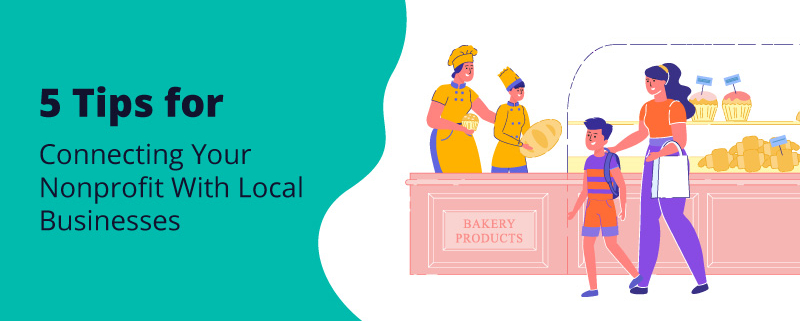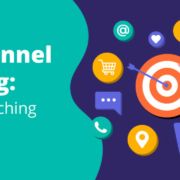4 Tips for Connecting Your Nonprofit With Local Businesses
Whether you’re seeking sponsorship, volunteer support, or joint marketing opportunities, establishing partnerships with businesses in your community is a powerful way to enhance your nonprofit’s impact. However, developing these partnerships can be challenging, time-consuming, and confusing without a strategic plan in place.
In this guide, we’ll explore four tips for connecting your nonprofit with local businesses. From identifying potential partners to creating win-win collaborations, these insights will help you build strong cross-sector relationships that support your mission and drive positive change in your communities.
1. Research and Identify Potential Partners
To identify potential partners in the community, a nonprofit can follow these steps:
- Define your objectives. Nonprofits often seek partnerships when organizing a large-scale fundraising event, launching a community initiative, or implementing a specific program that requires additional financial resources and support.
- Research local businesses. Conduct thorough research to identify businesses in the community. Utilize online directories, local business associations, chamber of commerce listings, and social media platforms to identify potential partners.
- Ensure your values align. Evaluate the values, missions, and corporate social responsibility initiatives of the identified businesses. Look for businesses that have a natural connection or alignment with your cause or mission. For example, a dog daycare business would be an obvious match for an animal shelter since they have similar clients and services.
Reach out to the identified businesses to introduce your nonprofit and express interest in exploring a potential partnership. This can be done through phone calls, emails, or in-person meetings.
2. Establish Clear Benefits
As you connect with local businesses, introduce your mission and communicate the benefits of a partnership. These may include:
- Community development: Partnering with a nonprofit allows businesses to contribute to community development and address social issues, which can have a direct impact on their growth.
- Elevated brand reputation. Collaborating with a nonprofit allows businesses to align themselves with a mission or social good cause, which can enhance their brand reputation and perception among customers, employees, and influencers in the community.
- Increased brand awareness. Add the business’s contact information and logo to marketing materials like fundraising flyers, event invitations, and partnership-related emails to increase their brand visibility. Or, create a personalized video about your sponsor and post it to your social media pages.
- Employee morale and engagement. Most employees value working for a socially responsible company. Creating matching gift programs, introducing volunteer opportunities, and sponsoring local nonprofits can improve their satisfaction.
- Tax benefits. Businesses may be eligible for tax benefits or incentives when they donate or support nonprofit organizations. These financial incentives can provide a tangible benefit to the business, helping to offset costs or improve the bottom line.
Customize these benefits to suit the specific goals, needs, and sectors of the businesses you’re approaching. For example, a pet rescue organization might ask a dog trainer to financially support their upcoming adoption event. In return, the pet rescue will use Gingr’s pet business software to promote the dog trainer’s services, potentially leading to an influx of new customers.
3. Create Tailored Partnership Opportunities
Develop opportunities that cater to different types and sizes of businesses. Offer a range of options, such as:
- Sponsorship opportunities: Sponsorships come in the form of financial or in-kind contributions. To incentivize larger gifts, Double the Donation’s guide to corporate sponsorships recommends creating tiered benefit packages that correlate to the level of support given. For instance, when you receive a donation of $10,000 or more, you might mention the business in a speech and display its logo on partnership-related materials. Businesses that give less than this might receive a social media shoutout instead.
- Auction item donations: Many businesses have relevant products or services that would be valuable items to auction off at your next event. For example, a local hotel could offer a weekend stay, or an airline headquartered in your city could offer round-trip tickets. No matter what the business has to offer make sure you’re thoughtful about how you make your auction item donation request.
- Joint initiatives: A joint initiative is a collaboration between a nonprofit and a partner organization, in which both work to create a mutually beneficial event, program, or campaign. It involves pooling resources and networks to achieve a greater impact than either organization could achieve alone.
- Employee engagement programs: Employee engagement programs focus on involving employees of a business or organization in volunteer activities, fundraising efforts, or other activities that support your nonprofit’s mission.
- Research collaborations: Nonprofits and businesses might partner together to research studies or projects related to their missions. For example, an animal welfare organization might partner with a dog boarding business to research the safest, most effective accommodations.
After presenting a business with a partnership opportunity, gauge their interest and thank them for their consideration, regardless of their decision. That way, they will be left with a positive impression of your organization.
4. Demonstrate Impact
If a business agrees to be your partner, take notes throughout the partnership, making note of successes and areas of improvement.
Then, in your outreach, explain the impact that the partnership has made on your nonprofit and the community as a whole. Share success stories, testimonials, or data that highlight the tangible outcomes of your programs or initiatives. This builds credibility and instills confidence in other potential business partners, showing them how their involvement will make a difference.
Remember, connecting with local businesses requires building meaningful relationships based on shared values and mutual benefits. By taking a strategic and personalized approach, your nonprofit can form valuable partnerships that amplify your impact and strengthen the communities you serve.










